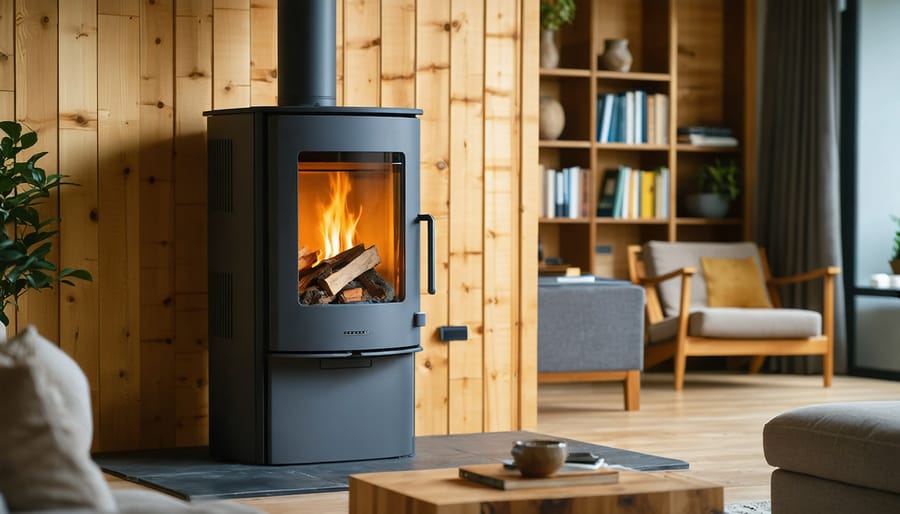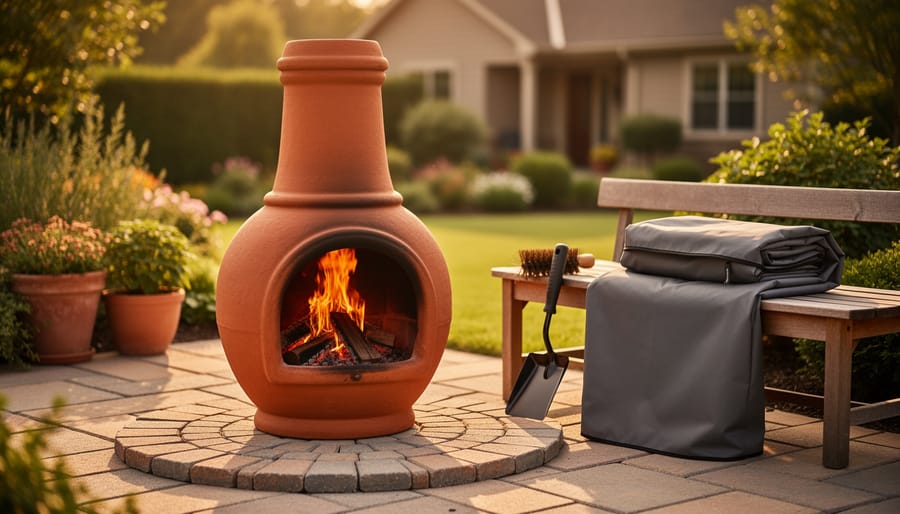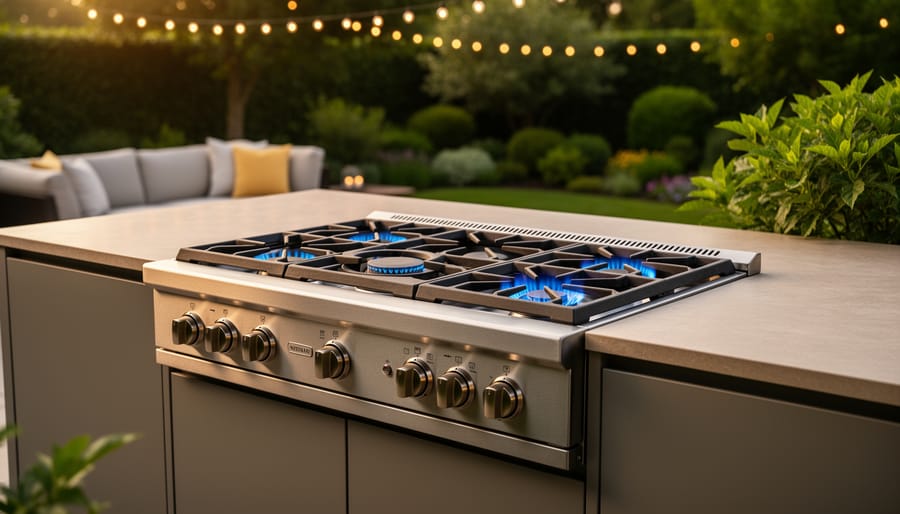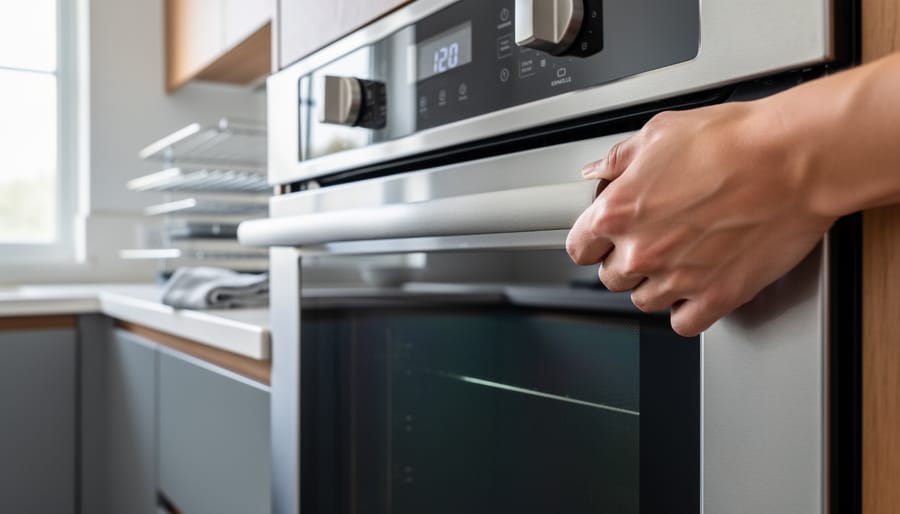Transform your home heating experience with a zero-clearance wood stove installation that maximizes both safety and efficiency in limited spaces. These innovative heating solutions allow for seamless integration into existing walls or corners, requiring minimal clearance from combustible materials thanks to their advanced insulation and ventilation designs. Unlike traditional wood stoves that demand substantial safety distances, zero-clearance models feature built-in air cooling chambers and thermal barriers, making them perfect for modern homes where space is at a premium. Whether you’re retrofitting an older home or planning a new construction project, these specialized stoves offer the perfect blend of traditional wood-burning charm and contemporary safety standards. By understanding the proper installation requirements and safety features of zero-clearance wood stoves, homeowners can enjoy the cozy warmth of a wood fire while maintaining peace of mind about their family’s safety and their home’s structural integrity.
What Makes a Wood Stove ‘Zero Clearance’?
Understanding Clearance Requirements
Traditional wood stoves typically require substantial clearance from combustible materials – often 18 to 36 inches on all sides. These clearance requirements ensure that heat radiating from the stove doesn’t create fire hazards with nearby walls, furniture, or flooring. However, zero clearance wood stoves are specifically engineered to need minimal space between the unit and surrounding materials.
What makes zero clearance designs different is their sophisticated insulation and air-cooling systems. These stoves feature multiple layers of heat shields and air chambers that effectively contain and manage heat distribution. The outer shell remains relatively cool while the inner firebox maintains high temperatures for efficient burning.
This innovative design allows these stoves to be safely installed as close as 2-6 inches from combustible walls, depending on the specific model and manufacturer specifications. Some units can even be placed directly against walls or built into existing fireplaces, making them perfect for smaller homes or rooms where space is at a premium.
Despite their space-saving benefits, it’s crucial to follow manufacturer guidelines and local building codes when installing any wood stove, as safety requirements can vary by region and model.
Safety Features and Design Elements
Zero clearance wood stoves incorporate several innovative safety features that make them ideal for installations where space is limited. The most notable feature is their double or triple-wall construction, which creates insulating air chambers around the firebox. This sophisticated design keeps the outer surfaces cool while containing the intense heat within.
These stoves are equipped with specialized thermal barriers and heat shields that effectively redirect and dissipate heat. The interior typically features high-grade insulation materials and reflective surfaces that maximize heat efficiency while minimizing external temperature transfer. Most models also include built-in air wash systems that help keep the viewing glass clean and ensure optimal combustion.
Safety is further enhanced by precise air intake controls and specially designed venting systems. The bottom and rear of these stoves often incorporate additional heat shields and cooling channels, allowing for safe installation against combustible materials. Many modern units also feature automatic safety shutoffs and temperature monitoring systems, providing peace of mind for homeowners while maintaining optimal performance.
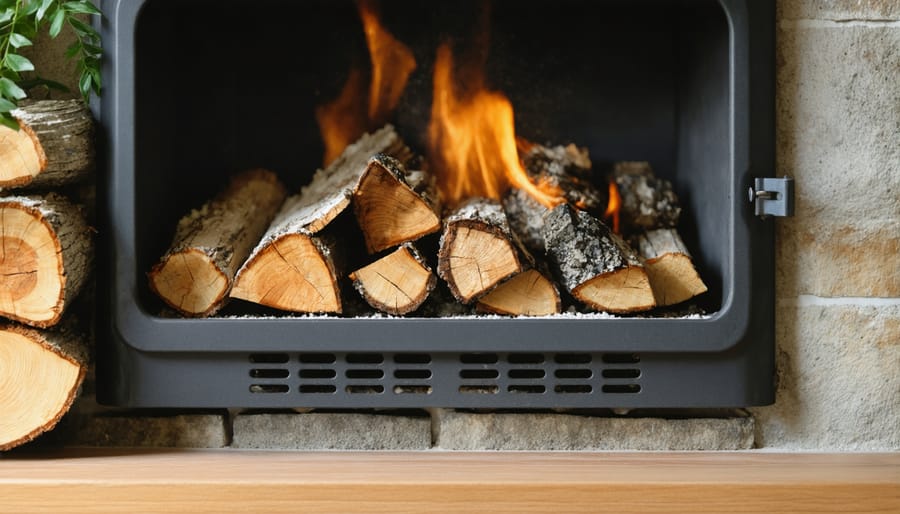
Maximizing Heating Efficiency with Zero Clearance Installation
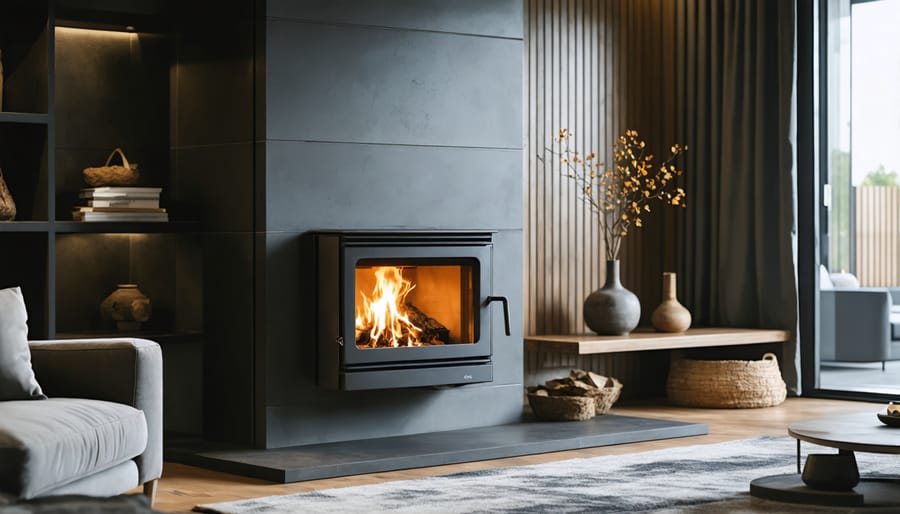
Heat Distribution Benefits
Zero clearance installation offers remarkable advantages when it comes to heating efficiency and comfort in your home. The design allows for optimal heat radiation by incorporating specialized insulation and air channels that effectively maximize heat distribution throughout your living space. Unlike traditional wood stove installations that may lose heat through nearby walls, zero clearance systems are engineered to direct more warmth into your room.
The clever design includes air spaces between the firebox and outer shell, creating a natural convection system. As the air within these channels warms up, it rises and flows into your living space, while cooler air near the floor is drawn in, creating a continuous cycle of warmth. This efficient circulation pattern ensures that heat is evenly distributed rather than concentrated in one area.
Moreover, the insulated construction helps maintain consistent temperatures by preventing heat loss through nearby walls or floors. This means you’ll need less firewood to achieve and maintain your desired room temperature, making zero clearance wood stoves both economical and environmentally conscious. The improved heat retention also means your stove will continue radiating warmth even after the fire has died down, providing lasting comfort throughout the colder months.
Energy Saving Advantages
Zero clearance wood stoves offer remarkable energy-saving advantages that make them an attractive choice for cost-conscious homeowners. These efficient heating systems can significantly reduce your home’s energy consumption by maximizing heat output while minimizing waste. When properly installed, they can convert up to 80% of the wood’s energy into usable heat, compared to traditional fireplaces that often operate at much lower efficiency rates.
One of the key benefits is the ability to direct heat precisely where you need it. Adding a wood stove fan can further enhance heat distribution throughout your living space, ensuring every corner of the room stays warm and cozy. This targeted heating approach means you can potentially lower your thermostat settings in other areas of your home, resulting in noticeable savings on your overall heating bills.
The insulated design of zero clearance wood stoves also contributes to their energy efficiency. By preventing heat loss through nearby walls and maintaining optimal burning temperatures, these stoves provide consistent warmth while consuming less fuel. Many homeowners report using 25-30% less firewood compared to traditional wood stoves or fireplaces, translating to substantial cost savings over the heating season.
Additionally, the sealed combustion system ensures a cleaner burn, maximizing the energy extracted from each log while reducing environmental impact. This efficient operation not only saves money but also aligns with eco-conscious heating practices.
Installation Considerations for Zero Clearance Wood Stoves
Ideal Placement Locations
When selecting the perfect spot for your zero clearance wood stove, strategic placement is crucial for maximizing its heating efficiency. The ideal location is typically in the room where you spend the most time, often the living room or family area. Corner installations are particularly effective, as they can improve heat circulation throughout multiple spaces simultaneously.
Consider positioning your stove on an interior wall rather than an exterior one to minimize heat loss. The lower level of your home is often the best choice, as heat naturally rises and will warm upper floors more effectively. If possible, place the stove in a central location that allows heat to distribute evenly throughout your living space.
Avoid placing the stove in areas with strong drafts or near windows and doors that are frequently opened. The layout of your room should also allow for proper air circulation around the stove while maintaining required clearances from furniture and décor. Remember that proper ventilation requirements will influence your final placement decision, so always factor in the path for the chimney or venting system when choosing your location.
Ventilation Requirements
Proper ventilation is crucial for a zero clearance wood stove installation to ensure safe and efficient operation. These systems require a dedicated chimney system, typically consisting of specialized double or triple-wall pipe designed specifically for zero clearance installations. The chimney must extend at least 3 feet above the roof and 2 feet higher than any part of the building within 10 feet horizontally.
Fresh air intake is equally important for optimal performance. Most zero clearance installations require an outside air kit that brings fresh air directly to the stove for combustion. This prevents the stove from competing with your home’s air supply and helps maintain proper draft.
The ventilation system should include proper termination caps to prevent downdrafts and keep out precipitation and debris. Regular inspection of all ventilation components is essential to ensure they remain in good working condition. For maximum efficiency, the chimney should be as straight as possible, with minimal bends or horizontal runs that could impede proper draft and increase the risk of creosote buildup.
Remember that local building codes may have specific requirements for ventilation configurations, so always consult with a certified professional during installation planning.
Professional Installation Tips
Professional installation of a zero-clearance wood stove requires careful attention to detail and adherence to safety guidelines. Always begin by thoroughly reviewing your local building codes and obtaining necessary permits. The installation surface must be perfectly level and capable of supporting both the stove’s weight and the required protective materials.
Proper ventilation is crucial – ensure your chimney system is correctly sized and installed according to manufacturer specifications. The chimney should extend at least three feet above the roof and two feet higher than any structure within ten feet. Install a proper chimney cap to prevent downdrafts and keep out debris.
When installing the heat shield and insulation components, make sure all seams are tightly sealed and properly overlapped. Pay special attention to the air space requirements between the stove and surrounding materials. Even with zero-clearance features, maintaining proper airflow is essential for safety and efficiency.
Don’t forget to install carbon monoxide and smoke detectors nearby. Once installation is complete, have everything inspected by a certified professional before your first fire. This ensures your installation meets all safety requirements and provides optimal performance.
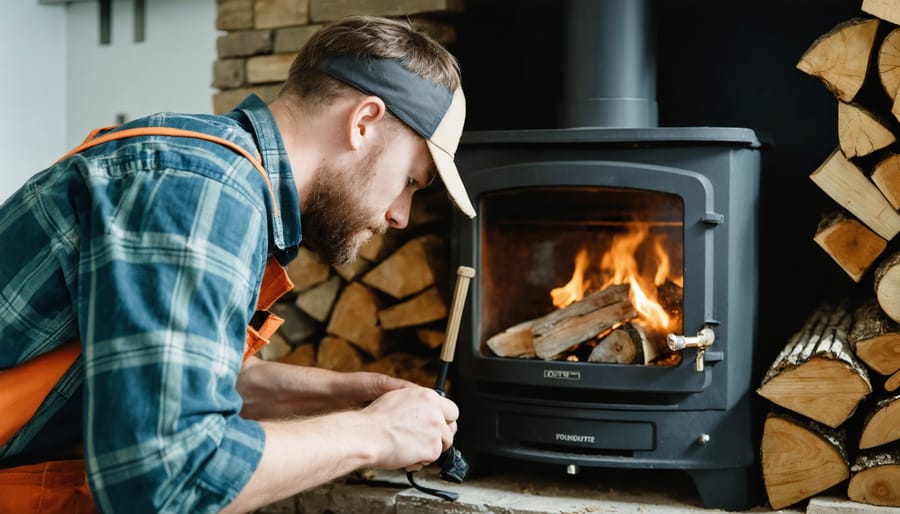
Maintenance and Long-term Care
Regular Maintenance Schedule
To keep your zero clearance wood stove operating safely and efficiently, follow this essential maintenance schedule. Monthly, inspect and clean the glass door using a specialized fireplace glass cleaner, and check the door gaskets for wear or damage. Clean out ash regularly, leaving only a thin layer for optimal burning.
Every three months, thoroughly inspect the chimney pipe and connections for creosote buildup, which can be a fire hazard. Check all seals and gaskets for proper function, and ensure the blower (if equipped) is free from dust and debris.
Annually, schedule a professional chimney sweep to clean and inspect your entire system, including the chimney cap and spark arrestor. This is also the time to check for any signs of wear in the firebox, replace worn gaskets, and lubricate door hinges and latches.
Before each heating season, verify that all safety features are working correctly, including smoke and carbon monoxide detectors. Keep detailed records of your maintenance activities to ensure nothing is overlooked and to maintain your warranty coverage.
Safety Inspections
Regular safety inspections are crucial for maintaining a safe and efficient zero clearance wood stove. At the start of each heating season, thoroughly examine all components, paying special attention to the chimney and venting system. Look for any signs of creosote buildup, which should be professionally cleaned if it exceeds 1/8 inch thickness.
Monthly inspections during the heating season should focus on checking gaskets, door seals, and the glass viewing panel for any damage or wear. Ensure all safety barriers remain securely in place and haven’t been compromised by heat or impact. The surrounding walls and floor should be examined for any discoloration or excessive heat transfer, which could indicate installation problems.
Don’t forget to test your carbon monoxide and smoke detectors regularly, replacing batteries as needed. Have a certified professional conduct an annual inspection to assess the overall condition of your unit, including hidden components and connections. They can spot potential issues before they become serious safety hazards and ensure your zero clearance wood stove continues to operate safely and efficiently throughout its lifetime.
Environmental Impact and Efficiency Ratings
Modern zero clearance wood stoves are designed with both environmental responsibility and heating efficiency in mind. These units typically achieve efficiency ratings between 70% and 85%, significantly higher than traditional open fireplaces that often operate at just 10-30% efficiency. This improved performance means more heat from your fuel and less waste going up the chimney.
Many contemporary models meet or exceed EPA (Environmental Protection Agency) emissions standards, producing less than 2.0 grams of particulate matter per hour. This is a remarkable improvement from older stove designs, which could emit 15-30 grams per hour. The reduced emissions result from advanced combustion technology that burns wood more completely, creating cleaner exhaust and maximizing heat output.
Zero clearance wood stoves often incorporate secondary burn systems that reignite smoke particles before they escape, further increasing efficiency while reducing environmental impact. This technology, combined with proper installation and heat powered accessories, can help homeowners achieve optimal heat distribution while maintaining eco-friendly operation.
When selecting a zero clearance wood stove, look for models with EPA certification and efficiency ratings clearly displayed. Many units now feature catalytic converters or non-catalytic systems that help achieve these superior environmental standards. Remember that using seasoned wood (dried for at least 6-12 months) and maintaining proper airflow will help your stove operate at peak efficiency, ensuring you get the most environmentally responsible performance from your investment.
Zero clearance wood stoves represent an excellent solution for homeowners seeking to combine the traditional charm of wood heating with modern safety and efficiency. These innovative installations have revolutionized the way we integrate wood-burning appliances into our homes, making it possible to enjoy the warmth and ambiance of a wood fire in spaces previously considered unsuitable.
The key advantages of zero clearance wood stoves are clear: enhanced safety through proper insulation, flexibility in installation locations, and the ability to fit into smaller spaces without compromising on heating efficiency. Their pre-fabricated design ensures consistent performance while meeting strict safety standards, giving homeowners peace of mind along with reliable heat output.
When considering a zero clearance wood stove installation, remember to factor in professional installation costs, proper ventilation requirements, and regular maintenance needs. While the initial investment might be higher than traditional wood stoves, the long-term benefits of improved safety, energy efficiency, and versatility often justify the expense.
For environmentally conscious homeowners, these stoves offer an excellent way to reduce reliance on fossil fuels while enjoying the renewable benefits of wood heating. With proper installation and maintenance, a zero clearance wood stove can provide years of reliable, efficient heating while adding value and charm to your home. Whether you’re renovating an existing space or building new, these versatile heating solutions deserve serious consideration for your home heating needs.

